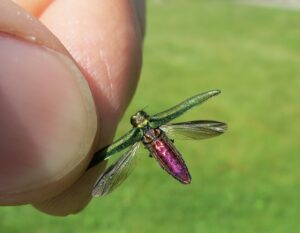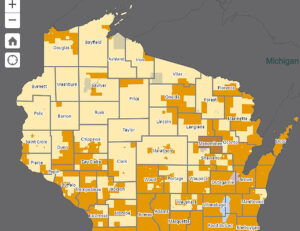
Adult emerald ash borer beetle. Photo: Wisconsin DNR.
By Linda Williams, DNR Forest Health Specialist, Woodruff
Linda.Williams@wisconsin.gov or 920-360-0665
Vilas County has the dubious distinction of becoming the first new Wisconsin county in 2023 to have a discovery of emerald ash borer (EAB).
EAB continues to spread into areas of northern Wisconsin. The first Vilas County detection was in the town of Lincoln. Additional infested trees have since been found in the town of Cloverland and the city of Eagle River.

On this map, darker gold areas denote townships or municipalities where EAB has already been found. Graphic: Wisconsin DNR
It is likely that the discoveries are a result of natural spread from the south. EAB has been present in Oneida County for a few years. EAB was first identified in Wisconsin in 2008 and has since been detected in 67 of Wisconsin’s 72 counties.
EAB was federally deregulated as of January 2021, shifting responsibility to states. Wisconsin instituted a statewide quarantine in 2018. As a result, there are no regulatory changes in Vilas County after the recent finds.
Many areas of northern Wisconsin do not yet have EAB, and in others EAB has only been found in the last three to five years. The interactive Wisconsin EAB Detections Look-Up map shows townships and municipalities in which EAB has been confirmed.
Contact your local forest health specialist if you know of an infested area that is not highlighted on the map.
As EAB expands to northern regions of the state, there is a higher presence of black ash for it to infest. It takes fewer EAB larvae to attack and kill a black ash, compared to a green ash or white ash. This means that black ash will have fewer EAB galleries under the bark, and consequently less woodpecker flecking than typically seen with green ash or white ash.
Woodpecker flecking occurs when the birds flake off outer layers of bark on infested trees to reach EAB larvae under the bark more easily.
Each forest site has different soils, hydrology, ash species and landowner goals. It can be overwhelming to try to decide what management techniques, if any, to use on each stand. If you already have EAB in your stand, or if your trees are declining or are already dead, you will have different questions than those who don’t yet have EAB.
The DNR and partners have developed Emerald Ash Borer Silviculture Guidelines to help landowners make decisions about the management of their woods. For further guidance, please contact your local forester for help deciding what would work best to achieve your goals on your land.
For homeowners who want to use insecticides to protect their trees from attack by EAB, a useful document from UW Extension lists what insecticides can be used and how to use them.
